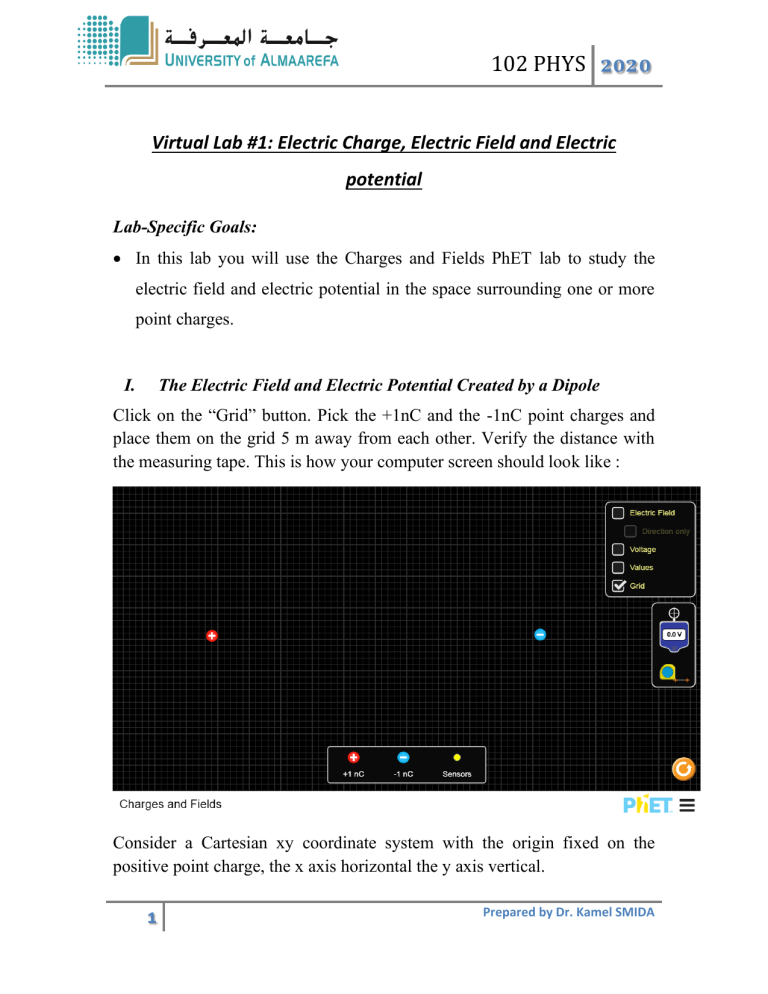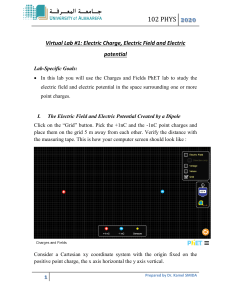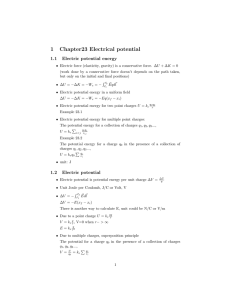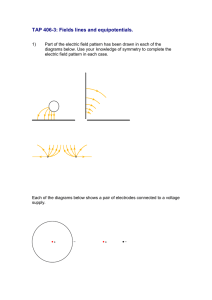
102 PHYS 2020 Virtual Lab #1: Electric Charge, Electric Field and Electric potential Lab-Specific Goals: • In this lab you will use the Charges and Fields PhET lab to study the electric field and electric potential in the space surrounding one or more point charges. I. The Electric Field and Electric Potential Created by a Dipole Click on the “Grid” button. Pick the +1nC and the -1nC point charges and place them on the grid 5 m away from each other. Verify the distance with the measuring tape. This is how your computer screen should look like : Consider a Cartesian xy coordinate system with the origin fixed on the positive point charge, the x axis horizontal the y axis vertical. 1 Prepared by Dr. Kamel SMIDA 102 PHYS 2020 A. Click on the “Electric Field” button: the electric field vector will be displayed on the screen. You can use the electric field sensor to measure the magnitude and direction of the electric field at different locations. Electric field sensor B. Calculate the magnitude and direction of the electric field at the following locations, then compare with values obtain from the simulation : agudeE m ointE tude mag magni et E E nitud e nitud mag et E mag nitud mag tE de nitu Point E magnitude E direction E magnitude E direction calculated Calculated “Measured” “Measured” Point A located 1 midway between the charges Point B located 2 at (x=1m, y=1.5m) Point C located 3 at (x=4 m, y=1.5m) 2 Prepared by Dr. Kamel SMIDA 102 PHYS 2020 With your phone take a picture of your calculations and insert it here to show your work. 3 Prepared by Dr. Kamel SMIDA 102 PHYS 2020 C. Calculate the electric potential at the same locations and compare with the values “measured” with the equipotential meter. Do not forget to include sign. agudemagnitude m ointE Point ude magnit E itude magn E V calculated V “Measured” 1 Point A located midway between the charges 2 Point B located at (x=1m, y=1.5m) 3 Point C located at (x=4 m, y=1.5m) With your phone take a picture of your calculations and insert it here to show your work. 4 Prepared by Dr. Kamel SMIDA 102 PHYS 2020 D. Click on the pencil drawing too attached to the equipotential meter: you will see a green equipotential line. Use the tool to draw equipotential lines every 0.5 m on each side from the midpoint. Take a screen shot of the picture you got and copy it here 5 Prepared by Dr. Kamel SMIDA 102 PHYS 2020 E. Calculate the change in the potential energy ΔP of a test charge q 0 = 1 pC , when moved from point P( x= 1 m, y = 0) to point Q( x= 2.3 m, y = 0). 1pC = 10-12 C Record your value: II. The Electric Field and Electric Potential Created by a Three Point charge distribution You will study the electric field and electric potential created by three point charges at following locations:+1nC at (x = 0 and y = +1.5 m), +1nC at (x = 0 and y = -1.5 m) and -1nC at (x = 5 m and y = 0) as shown in the picture and -1nC at (x = 5 m and y = 0), as shown in the picture below: 6 Prepared by Dr. Kamel SMIDA 102 PHYS 2020 A. Calculate the electric field at x = 2.5 m and y = 0 and compare with values obtain from the simulation tude mag magni E et E E nitud e nitud mag et E mag nitud mag tE de nitu Point E magnitude E direction E magnitude E direction calculated Calculated “Measured” “Measured” Point A located at (x=2.5 m, y=0) With your phone take a picture of your calculations and insert it here to show your work. 7 Prepared by Dr. Kamel SMIDA 102 PHYS 2020 B. Draw equipotential lines at this point. Draw equipotential lines by moving the equipotential meter 0.5 m away on each side of this point. Take a screen shot of your results showing the electric field vectors at different locations and the equipotential lines that you have drawn. Copy the picture here. 8 Prepared by Dr. Kamel SMIDA





